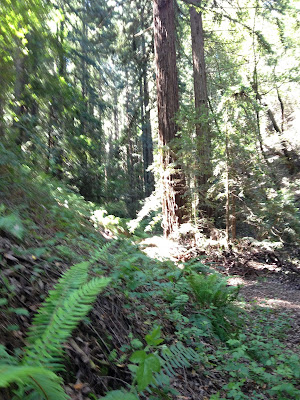Redwood Springing-into-Summer Song
 |
| The trees shone in the morning sun with ferns in the shady canyon. |
The cool morning air was a relief after the last few days of temperatures that soared to 90 degrees. After the long, rainy winter, the heat spike engulfed the Bay Area like an environmental hot flash. So Adventure Dog and I set out to check on Spring's progress at Redwood Regional Park in the Oakland Hills.
 |
| My faithful companion, always ready for adventure! |
Following Bridle Trail from the Fish Ladder along Redwood Creek, a few muddy patches showed we were on the shady side of the canyon with redwoods just ahead of us. The stream bounded along, burbling and gushing over the rocks and bouncing down the concrete fish ladder. A historical marker commemorates the naming of rainbow trout by Dr. William P. Gibbons, founder of the California Academy of Science, from this creek in 1855. They've since been introduced worldwide. Rainbow trout are anadromous fish, migrating after they hatch and grow in freshwater creeks to spend their lives at sea. They return only to lay eggs in their natal creek. The Redwood Creek trout, though, are now landlocked by the reservoirs downstream. They migrate only from the reservoirs to this creek and back, never becoming salt-water dwellers.
 |
| A fallen redwood reminded me of a large valentine. |
Hiking further along the creek, songbird calls resounded from the riparian trees. Male birds are announcing their territories while the female sits camouflaged on a nest. Some of the songbirds migrate here from a warm winter in Mexico, traveling along the Pacific Flyway. [migratory songbirds http://www.birdday.org/] Others move to the forest from closer wintering grounds. It's a fun challenge to try and identify some of the birds in spite of their bright spring colors. They are quick, moving through the foliage and blend in with the leaves. Click on the birds below to enjoy their songs and see more about them.
Bullock's Oriole - a colorful forest bird
Wilson's Warbler - small but might with a dark cap on the male's head
Chestnut-backed - one of the cutest forest birds
Dark-eyed Junco - watch for them feeding their newly fledged young on the ground
Swainson's Thrush - the flutest of the forest with one of the most magical songs
 |
| Dainty Redwood Sorrel blooms on the shaded floor beneath the trees. |
 |
| Scouring rush alongside the trail. |
Scouring rush rose in small stands along the trail. It was present in the time of dinosaurs, as were ferns, giving a long lens into our area's history. I would oftentimes tell children in Redwood programs to "shake hands" with the ferns and thank them for providing the energy we use today - petroleum, natural gas, and coal. The back of the fern leaves had many spores ready to start new plants.
I hope you'll get a chance to get out and enjoy these early summer treats, from birds to blooms, forests, hills and shorelines. Comment below to share your favorite hiking areas and what makes them special.

Comments
Post a Comment